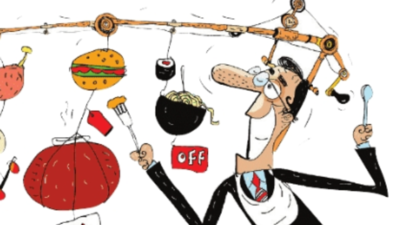ARTICLE AD BOX

Before the term ‘cloud kitchen’ entered the startup lexicon, delivery-only kitchens were already operating quietly in Bengaluru’s back alleys and industrial pockets. With no storefronts, signage, or foot traffic, these kitchens served a new kind of diner — one tapping a phone screen instead of walking into a restaurant.Over the past decade, Bengaluru has emerged as India’s hub for cloudkitchen innovation. From early players like FreshMenu and Faasos to newer brands using AI and heatmaps to optimise menus, the city has played a key role in shaping how India eats — largely from behind closed doors.Cloud kitchens — also called dark or ghost kitchens — are simple in concept: commercial kitchens built exclusively for delivery. Behind that simplicity lies a tech-first, highly optimised food operation that’s evolved through multiple it-erations.
Bengaluru’s startup DNA, high delivery frequency, and dense, young population have accelerated this evolution faster than in any other Indian city.
The first wave of cloud kitchens began around 2014-16, led by FreshMenu, Box8, and Faasos, offering affordable, single-serve meals for officegoers and young professionals. These brands focused on packaging, consistent menus, and tight delivery logistics — elements that continue to define the sector today.
As food delivery scaled, platforms began investing in infrastructure. Swiggy piloted Swiggy Access in Bengaluru, offering kitchen spaces to brands looking to expand without opening dine-in outlets. Zomato, too, experimented with shared kitchen pods.The Covid-19 pandemic in 2020 gave the model an unexpected boost. With restaurants shut, cloud kitchens became essential. For many new-age food brands, it was the only viable operating model.
Home chefs, small bakeries, and direct-to-consumer (D2C) brands found their footing through aggregator platforms. Consumers, too, grew comfortable ordering in — often daily.Beyond the pandemic-driven demand, it was Bengaluru’s unique blend of tech talent and appetite that helped the model thrive. Founders and investors say the city records the highest per-capita food delivery frequency in India. That makes it an ideal launchpad for testing new brands, menus, and formats before scaling to other metros.
Areas like HSR Layout, Koramangala, Whitefield, and Sarjapur quickly became delivery-first hotbeds.Former tech professionals and product managers have been at the forefront of this shift. Many left jobs at unicorn startups to build food brands designed like SaaS companies — driven by data, performance marketing, and rapid prototyping. “Running a cloud kitchen here is closer to running a D2C tech brand than a restaurant,” said the founder of a multi-brand food company based in Bengaluru.The kitchen back-end has also transformed. AI is now used to determine which dishes to offer, where to launch, and how to bundle meals — down to targeting someone placing a late-night order. Bengaluru-based Mukunda Foods has built robotic cooking systems now deployed across kitchen networks nationwide.Another early trend in the city: Creator-led food brands. Influencers and home chefs with strong online followings are co-creating menus with kitchens.
These collaborations are built on digital storytelling and trust, with little reliance on traditional branding. The brand may be invisible on a map but enjoys deep local reach.The city’s palate is also shifting. While biryani remains a bestseller, demand for South Indian breakfast combos, millet-based thalis, and health-forward fusion meals is rising. Operators say consumers increasingly seek low-carb wraps, khichdi cups, and neatly portioned single-serve meals — packed and priced for everyday convenience.With 10-minute delivery platforms like Zepto and BlinkIt gaining traction, cloud kitchens are catering to impulse consumption too. Newer kitchens are creating mini-meals, snacks, and desserts tailored for quick commerce. Festivalspecific bundles and curated gift packs are also becoming popular.Challenges persist. Competition is intense, and customer acquisition costs are rising. Founders say visibility on aggregator apps is crucial -dropping from top listings can sharply impact order volumes.
Some brands have shut down due to pricing pressure or lack of discoverability.Brand recall is another hurdle. Consumers often remember the dish, not the brand. With aggregators acting as primary discovery engines, building direct customer loyalty is hard—unless brands operate their apps or WhatsApp-based ordering channels.There are also regulatory concerns. Some cloud kitchens operate from residential or semi-commercial spaces with limited oversight.
Operators have reported shutdowns over fire safety issues or neighbour complaints.As the model matures, new directions are emerging. Micro kitchens— compact pods inside housing societies or basements—are gaining popularity. Sized under 150sqft, they allow hyperlocal delivery with minimal costs and quicker turnaround.Others are merging warehousing with food prep, creating co-fulfilment hubs that stock raw materials, prepare meals, and dispatch orders from a single location.
Some of these setups are being built in collaboration with delivery platforms, blurring the lines between logistics, real estate, and food operations.A former Swiggy executive noted that the future of urban food delivery may not lie with large restaurant chains, but in hyperlocal food nodes — invisible to consumers but tightly integrated with data, logistics, and local demand.Cloud kitchens in Bengaluru have come a long way from their biryani bowl and salad jar origins. What began as a rent-saving workaround has become a data-led, AI-powered business model at the intersection of consumption, technology, and logistics.As food-ordering behaviour continues to evolve, Bengaluru’s kitchens are set to stay ahead —quietly, efficiently, and straight from the cloud.



.png)
.png)
.png)
















 12 hours ago
3
12 hours ago
3









 English (US) ·
English (US) ·